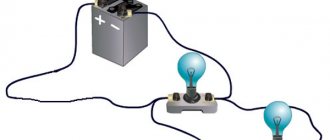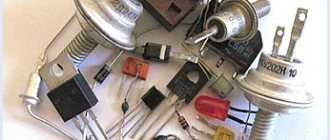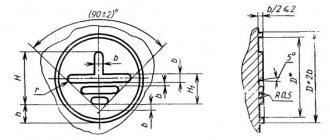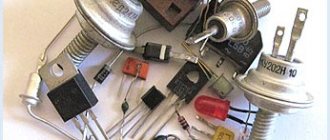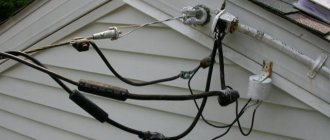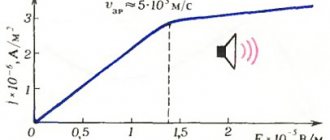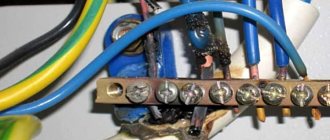Conductors
Let's start with a definition.
A conductor is a body through which electric charges can pass from a charged body to an uncharged one.
Examples of conductors:
- metals
- the soil
- water with salts, acids or alkalis dissolved in it
- graphite
The best conductors are metals . Silver, copper and aluminum have the highest conductivity.
Our bodies also conduct electricity. We are very unique guides. This can be easily checked by touching any charged body, for example, the petals of an electroscope. The charge will transfer to us, and then go through the floor into the ground.
In all these substances and in our body there are free electrons, which carry charge.
Electron flow/electric current
Although the normal movement of "free" electrons in a conductor is random, with no specific direction or speed, electrons can move through a conductive material in a consistent manner. We call this movement of electrons in a given direction electricity or electric current. More precisely, it can be called dynamic electricity, as opposed to static electricity, which is a stationary accumulation of electrical charge. Like water flowing through the void of a pipe, electrons can move through the empty space within and between the atoms of a conductor. A conductor may appear solid to our eyes, but any material made up of atoms is mostly empty space! The analogy to fluid flow is so apt that the movement of electrons through a conductor is often called “flow.”
A remarkable observation can be made here. As each electron moves systematically through the conductor, it pushes the electron in front, and therefore all the electrons move together as a group. The start and stop of the flow of electrons along the entire length of a conductive path occurs almost instantly from one end of the conductor to the other, even though the movement of each electron may be very slow. A rough analogy is a tube completely filled with balls:
Figure 1 – Tube with balls as an analogy for electron flow
The tube is filled with balls, just as a conductor is full of free electrons, ready to be moved by external forces. If one ball is inserted into this full tube on the left side, another ball will immediately try to exit the tube on the right. Even though each ball has traveled only a short distance, the transfer of motion through the tube is almost instantaneous from the left end to the right, regardless of the length of the tube. With electricity, the overall effect from one end of a conductor to the other occurs at the speed of light: a rapid 300,000 kilometers (~186,000 miles) per second!!! However, each individual electron moves much more slowly through the conductor.
Flow of electrons through a wire
If we want electrons to flow in a certain direction to a certain place, we must provide them with the right path, just as a plumber must install a pipeline so that water flows where he wants it to flow. To facilitate this, wires are made in a variety of sizes from highly conductive metals such as copper or aluminum.
Remember that electrons can only flow when they have the ability to move through the space between the atoms of a material. This means that electric current can only exist where there is a continuous path of conductive material providing a channel for electrons to pass through. In the tube analogy, beads can flow into the left side of the tube (and therefore through the tube) if and only if the tube is open on the right side for the beads to flow out. If the tube is blocked on the right side, the beads will simply "pile up" inside the tube and there will be no "flow" of beads. The same is true for electric current: a continuous flow of electrons requires a continuous path to allow that flow. Let's look at a picture to illustrate how this works:
Figure 2 – Wire
The thin solid line (shown above) is a symbol for a continuous piece of wire. Because a wire is made of a conductive material such as copper, its constituent atoms have many free electrons that can easily move around the wire. However, there will never be a continuous or uniform flow of electrons in that wire unless they have somewhere to come from and a place to go. Let's add a hypothetical "source" and "destination" of electrons:
Figure 3 – Source and destination of electrons
Now, as the electron source pushes new electrons into the wire on the left, a flow of electrons through the wire can occur (as indicated by the arrows pointing from left to right). However, the flow will be interrupted if the conductive path formed by the wire is disrupted:
Figure 4 – Disturbance in the flow of electrons through the wire
Electrical continuity
Because air is an insulating material and there is an air gap separating the two pieces of wire, the once continuous path has been broken and electrons are now unable to flow from source to destination. It's like cutting a water pipe in two and sealing the ends where it breaks: water can't flow if there's no way out of the pipe. From the point of view of electricity, we had a state of electrical continuity when the wire was intact, and now this continuity is broken because the wire is cut and divided.
If we were to take another piece of wire leading to the destination and simply make physical contact with the wire leading to the source, we would again have a continuous path for the electrons to move. The two dots in the diagram indicate physical contact (metal-to-metal) between the pieces of wire:
Figure 5 – Metal to metal connection
Now we again have continuity from the source to the newly created connection, down, to the right and up to the destination. This is analogous to installing a tee in one of the closed pipes and directing water through the new section of pipe to its destination. Notice that no electrons flow through the broken piece of wire on the right side because it is no longer part of the complete path from source to destination.
It is interesting to note that due to this electrical current, no “wear and tear” occurs within the wires, unlike water pipes, which eventually corrode and wear out due to continued flow. However, as electrons move, they encounter some friction, and this friction can generate heat in the conductor. We will look at this topic in more detail later.
Non-conductors
Let's give a definition.
A dielectric/non-conductor is a body through which electric charges cannot pass from a charged body to an uncharged body.
Examples of dielectrics:
- ebonite
- amber
- rubber
- porcelain
- plastic
- silk
- oil
- nylon
- air and gases
- glass
- dry wood
All these substances have in common the absence of free electrons. They are also used for the manufacture of isolates or insulation .
Semiconductors
These bodies are intermediate in their ability to transfer electrical charges between conductors and dielectrics.
A semiconductor is a body that does not conduct electricity at low temperatures, but begins to conduct electricity at higher temperatures.
What does this mean? The fact is that at low temperatures semiconductors are dielectrics. They are not capable of transmitting any charge.
Let's raise the temperature. The atoms of a substance begin to vibrate more strongly around their equilibrium positions. These vibrations reach such a force that the electrons located on the outer shells of the atoms (valence electrons) become free. This is how a semiconductor becomes a conductor.
What characteristic feature do semiconductors have? As the temperature increases, their conductivity increases . Interestingly, for metals, on the contrary, it will decrease.
Note that this temperature is not always very high. For example, for silicon and germanium it is about $20 \degree C$.
Examples of semiconductors:
- metal oxides and sulfates
- germanium
- silicon
- some organic matter
Due to their properties, semiconductors are widely used in technology. They are often used as a kind of thermometer. For example, they are used as temperature-dependent resistors. This allows you to control the flow of current at certain temperatures. When it reaches a critical point, some part of the circuit stops conducting current or, conversely, begins. We will talk in more detail about the electrical circuit and its components in the following lessons.
Semiconductors begin to conduct electricity under other influences on them:
- exposure to light
- transmission of a stream of fast particles
- introduction of impurities
Photoconductivity is the phenomenon of increased conductivity of a substance when exposed to light.
This phenomenon allows semiconductors to be used in remote control and alarm systems. We can say that the scope of semiconductors in technology is itself very wide. They are an integral part of microcircuits in televisions, computers, radios, and are used to create transistors, diodes, etc.
Thermal conductivity
λ is a quantity characterizing the amount of heat passing per unit time through a layer of matter. Thermal conductivity dimension
Thermal conductivity is of great importance in thermal calculations of machines, apparatus, cables and other electrical devices.
Thermal conductivity value λ for some materials
| Silver Copper Aluminum Brass Iron, steel Bronze Concrete Brick Glass Asbestos Wood Cork | 350 – 360 340 180 – 200 90 – 100 40 – 50 30 – 40 0,7 – 1,2 0,5 – 1,2 0,6 – 0,9 0,13 – 0,18 0,1 – 0,15 0,04 – 0,08 |
From the data presented it is clear that metals have the greatest thermal conductivity. Non-metallic materials have significantly lower thermal conductivity. It reaches especially low values for porous materials, which I use specifically for thermal insulation. According to the electronic theory, the high thermal conductivity of metals is due to the same conduction electrons as electrical conductivity.
Conductivity and electrification
Let us note an important point. You should never confuse electrification and conductivity.
Bodies that are not conductors may well have the ability to become electrified.
Electrification occurs through direct contact of bodies. Conduction occurs inside the body.
During electrification, one body loses electrons and the other gains. Conduction or electric current (more on that in the next lesson) describes the orderly movement of particles within a body.
Exercises
Exercise No. 1
Why does a charged electroscope discharge when its ball is touched by hand?
Our body is a conductor of electricity . When we touch the ball of a charged electroscope, the charge (free electrons) goes into our body. When we come into contact with the floor and the ground, the charge will go there. This happens if the electroscope is negatively charged.
If the electroscope is positively charged, then by touching it, we neutralize the charge by giving it a certain number of electrons. After all, being a conductor, our body has a large number of free electrons.
Exercise No. 2
Why is the rod of an electroscope made of metal?
Metals are good conductors. The metal rod can transfer charge from the ball to the petals.
If you make a rod from a dielectric, then the charge will not be transferred, and the electroscope will not work.
Exercise #3
A positively charged body is brought to the ball of an uncharged electroscope without touching it.
What charge will appear on the leaves of the electroscope? Note that the body is not touching the electroscope. As it approaches, a negative charge is formed on the ball, and a positive charge on the petals.
The electric field of a positively charged body will act on the electroscope, free electrons will begin to move. The attractive forces between unlike charges will force them to gather on the ball. In another part of the electroscope (on the petals), a lack of electrons is formed and a positive charge is formed.
Temperature coefficient of resistance
α is a value characterizing the change in conductor resistance depending on temperature. The average value of the temperature coefficient of resistance in the temperature range t2° - t1° can be found by the formula:
The temperature coefficients of resistance of various conductor materials are given in the table below.
The value of temperature coefficients of resistance of metals
| Name of metal | Temperature coefficient of resistance, 1/°С |
| Aluminum Aldrey Bronze Tungsten Gold Brass Copper Molybdenum Nickel Tin Platinum Mercury Steel Silver Lead Zinc Cast Iron | 0,00403 – 0,00429 0,0036 – 0,0038 0,004 0,004 – 0,005 0,0036 0,002 0,004 0,0047 – 0,005 0,006 0,0043 – 0,0044 0,0025 – 0,0039 0,009 0,0057 – 0,006 0,0034 – 0,0036 0,0038 – 0,004 0,0039 – 0,0041 0,0009 – 0,001 |
